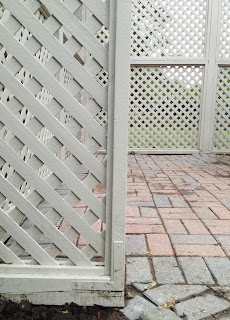Her History
What is age but a number? At twenty, she was starting to show hers. With roots in Louis XIV France, she came from a great line -- noble, elegant, classic. A real beauty. Unfortunately, she was looking more ugly duckling than serene swan. A tear down? it was foolishly suggested. I think not! A resurrection is what she needed: To be buff and sanded, primed and painted -- after some detailed repairs, that is. Today, she sits, a crowning jewel in the garden. She is the architectural structure that creates perspective, acts as a focal point, and provides privacy. She is our gazebo, a place in which we entertain, or simply sit and enjoy the patterned shadows she creates. In a few weeks, the work crew will reassemble for a party, and we will be toasting her and the next twenty years.
 |
| With a brick floor, she is painted and ready for planting along the exterior walls |
Her Lineage
Steeped in history, the origins of treillage traces back to the 12th century when gardeners constructed rudimentary structures or frameworks called treille on which climbing plants were trained. In the 17th century, Louis XIV hired landscape architect Andre Le Notre to design the gardens at Versailles. To create an architectural presence and elegant formality, he employed treillage; while it would take years for trees, hedges and topiaries to reach maturity, treillage offered instant drama and structure. As other royal households sought to emulate everything French, the art of treillage spread throughout Europe. Today, treillage can be found inside and outside the home: in the garden it can add interest, create a strong focal point, establish a sense of depth, train climbing plants, bring beauty to a facade or offer privacy; inside, latticework fabric or wall covering and treillage-inspired furniture can bring a strong graphic element to any room.
Her Makeover
It included new hardware and footings,
And new woodwork,...
And new paint -- "Stone Hearth" by Benjamin Moore, inspired by the stonework that frames our house's windows.
Now she is ready for her closeup.
The next steps: furnishing, planting, decorating (a.k.a. the really fun part).
Her Inspiration: Other Well-Placed Treillage
A charming rustic trellis in a garden
photographed by Francois Halard.
photographed by Francois Halard.

In its most traditional and simplest form: as an
obelisk supporting climbing plants.
Here, trellis work graces a fence, vase,
bench, and chairs (and is the inspiration
for the patterned cushion) for a very
formal and elegant look.
In a more contemporary setting, it provides
privacy between neighbouring balconies.

In a more formal setting, again, it acts as a strong focal point in the garden providing architectural drama and support for climbing roses.

On the left it adds simple graphic appeal to a garden door, and
below, it creates a poolside focal point and suggests a sense
of depth through the mirrored archways in the centre of the
structure.

Photo Credits: Opening image and "Her Makeover" section, D. Sleziak;
Francois Halard picture through Trunk Achive; Trianon vase via Elle Decor;
Other images from Accents of France.









No comments:
Post a Comment